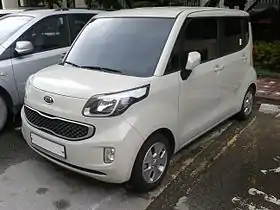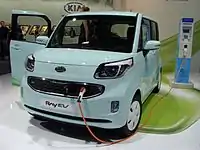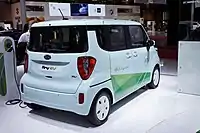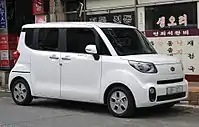Kia Ray
The Kia Ray is a city car manufactured by Kia Motors exclusively for the Korean domestic market.
| Kia Ray | |
|---|---|
 | |
| Overview | |
| Manufacturer | Kia Motors |
| Production | 2011–present |
| Assembly | Seosan Plant, Seosan, South Korea (Donghee) |
| Body and chassis | |
| Class | City car (A) |
| Body style | 5-door minivan |
| Layout | Front-engine, front-wheel-drive |
| Platform | Hyundai-Kia SA |
| Related | Kia Picanto (TA) |
| Powertrain | |
| Engine | 1.0 L Kappa II I3 (petrol) 1.0 L Kappa II I3 (petrol/LPG) 1.0 L Kappa II I3 (LPG) |
| Electric motor | 50 kW (67 hp) |
| Battery | 16.4 kWh lithium ion battery |
| Range | 138 km (86 mi) |
| Dimensions | |
| Wheelbase | 2,520 mm (99 in) |
| Length | 3,595 mm (141.5 in) |
| Width | 1,595 mm (63 in) |
| Height | 1,700 mm (67 in) |
| Curb weight | 1,040 kg (2,293 lb) |
Overview
The initial roll out was a limited production of 2,500 units destined for the South Korean government fleets, scheduled to be deployed in 2012. The Kia Ray EV was a predecessor to an all-electric crossover SUV that, as of 2011, Kia Motors had planned to launch globally in 2014.[1] In May 2013 a fleet of 184 Kia Ray EVs were deployed in Seoul as part of a carsharing service called "Electric Vehicle Sharing” at a rate of US$5 per hour. The service had 15,000 registered customers by May 2013.[2]
The Ray has a unique door layout; the passenger side of the vehicle has a sliding door for the rear seats, while the driver's side has a swing-out door.[3] The car has a kei car-inspired boxy dimensions. The Ray's interior benefits from the square shape, as it has more space than most cars its size; however, it is only able to seat four people.
The Ray EV is the Kia's first production battery electric vehicle. It is powered by a 50 kW (67 hp) electric motor, with a 16.4 kWh lithium ion battery that allows an all-electric range of 138 km (86 mi) depending on driving conditions.[4]
The Ray is also available in non-EV types equipped with gasoline and bi-fuel with a gasoline and liquefied petroleum gas (LPG) combination. Both engines are available in four trims - Deluxe, Special, Luxury and Prestige. Only available in the local Korea domestic market, both engines produce similar power and outputs. The gasoline engine generates 78 PS (57 kW; 77 hp) at 6,400 rpm and 9.6 kg.m/3,500 rpm. Both engines have displacements of 998 cc, generating fuel economies of 17 km/l for gasoline, and bi-fuel delivering 16.6 km/l on gasoline mode and 13.2 km/l on LPG mode. Gasoline engine models weigh in at 998 kg (2,200 lb) with bi-fuel models weighing in at 1,042 kg (2,297 lb). Both are equipped with a 4 speed automatic transmission, and are currently sold in the Republic of Korea.
Facelift
The Ray received a facelift for the 2018 model year. Changes consist of a new front end design with a closed grill and a revised interior.[3]
Gallery
 Kia Ray EV (front)
Kia Ray EV (front) Kia Ray EV (rear)
Kia Ray EV (rear) Right side featuring sliding rear door
Right side featuring sliding rear door Interior
Interior Facelift (front)
Facelift (front) Facelift (rear)
Facelift (rear)
See also
References
- "Kia Introduces Ray EV, We Offer Initial Impressions". Car & Driver. Retrieved 2011-12-22.
- Eric Loveday (2013-05-06). "South Korea Now Offers Electric Vehicle Rentals With Rollout of 184 Kia Ray EVs". InsideEVs.com. Retrieved 2013-06-07.
- Sarne, Vernon B. (2019-07-24). "The Kia Ray city car is nice, but can we really afford it?". Visor. Retrieved 2019-07-24.
- "New Kia Ray is Korea's first production EV". Autoblog Green. 2011-12-22. Archived from the original on 2012-01-09. Retrieved 2012-01-06.